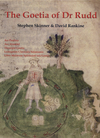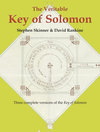Revealing the Books of Secrets

Over the last thousand years there have been several distinct streams of Western magical practice. Running parallel are the Grimoires, which focus on preparation and complex procedures to produce effective communication and interaction with spiritual beings, and the Books of Secrets, full of simple techniques using easily available ingredients. Both of these traditions have influenced many of the more recent magical traditions and practices that have developed in recent centuries, from Wicca and the Golden Dawn to Voodoo and Hoodoo. However, until recently the importance of the early Book of Secrets tradition has been largely ignored.
In some respects the Books of Secrets can be seen as being more important than the Grimoires. The Grimoires were hand-copied manuscripts, sold and traded amongst the wealthy, literate classes, whereas Books of Secrets were cheaply printed and widely distributed. The most famous Book of Secrets, an Italian work by Alessio Piemontese (called Secreti) was published in 104 editions in nine European languages between 1555 and 1699. These books were amongst the early best-sellers, and contained not only magical charms and spells but also a diverse spectrum of useful remedies and tips, from medical and gardening hints to cosmetics and metalwork. Such books sold not only to the middle classes, but also at village fairs and wherever an audience could be found.
From the mid-seventeenth century scientists would start to repudiate Books of Secrets as propagating fake secrets and vulgarities with no basis in fact, and as purveying dubious folklore and esoterica that were challenged by the ongoing Scientific Revolution. Nevertheless, in societies where a university education remained an expensive privilege, the Books of Secrets remained popular well into the eighteenth century.
Grimoire manuscripts often contain Book of Secrets material bound in the back, providing the simple remedies for the day-to-day problems that did not require the long and involved conjuration process, which had been successfully used or picked up in the course of reading. These snippets are often drawn from books like Agrippa’s De Occulta Philosophia, and the works ascribed to Albertus Magnus. A good example of this is A Collection of Magical Secrets (Rankine & Barron, Avalonia, 2009), which contains numerous simple folk and Psalm charms and other practices, and was bound at the back of a Key of Solomon (published as The Veritable Key of Solomon, Skinner & Rankine, Llewellyn, 2009). manuscript. Indeed, the seventeenth through nineteenth century French pseudo-grimoires of black magic, such as the Grimoire of Pope Honorius III, the Red Dragon, and Grimorium Verum are often full of such procedures.
The Book of Secrets material was ideal for cunning-folk, who drew on such works, as well as books like Thomas Heydon’s Theomagia, Francis Barrett’s The Magus, the works of Agrippa, and others for material to use in their written charms. Such charms, which often used biblical quotes and Psalms, were the stock-in-trade of the cunning-folk, and were a large component of their power in a largely illiterate rural environment. In this they were continuing the Church tradition of providing written amulets for money (which only started to move into secrecy in the fifteenth century).
I recently worked on a unique document called The Grimoire of Arthur Gauntlet, a seventeenth century London Cunning-man’s Book of Practice, which combines material from Grimoires and Books of Secrets. This text exemplifies the cunning art, drawing together material that includes conjurations of angels, demons, fairies, and the dead, as well as a diverse range of charms. The charms include earlier medical charms written by famous surgeons from the fourteenth and fifteenth century, herbal remedies, wax images, and charms using the Psalms, many of which are also seen in The Book of Gold (a collection of charms using the Psalms).
Thus these books contain scripture-based remedies, such as: "Write Psalm 38 on a piece of paper and put it under the right side of your pillow to prevent nightmares" or, "Say Psalm 66 seven times to alleviate food poisoning." And conversely, they also had simple folk charms, such as "Write in an apple your names and these three names Gosmer Synady Heupide, And give it to eat to any man that thou wouldst have after thy will and he shall do as thou wilt."
The eclectic nature of the Book of Secrets tradition has flowered over the centuries, resulting in much we now take for granted. The use of rhyming couplets in spells; herbal charms for love, protection, and health; incense recipes; simple magic circles; working the phases of the moon—all of these modern Pagan magical practices and many more were drawn together and propagated through this simple and practical tradition of folk magic.
Of course, the use of grimoires and Books of Secrets was not exclusively a British preserve, and the French and Italian influences are especially important. In the detailed records of the numerous trials of the seventeenth century Venetian witch Laura Malapiero, there are some extremely significant details about the documents in her possession. These sound like both Books of Secrets (crudely written spells) and also the Key of Solomon:
"When Laura's house was searched by the Capitano of the Sant'Ufficio in 1654, a number of manuscripts were found. Some were rather crudely written scongiuri [spells]; others were sophisticated herbals and copies of the Clavicle of Solomon."1
The Italian connection is key, as it was the entry point into Europe, through which the material preserved in Byzantium passed. Such material included the Hygromantia (the proto-Key of Solomon, written in Greek), as well as works from the Arabic world (which had preserved much of the Greek magic that would have otherwise have been lost). When this is combined with the explosion of material from Italy during the Renaissance on Kabbalah, Hermeticism, and Neo-Platonism, Italy’s role as the midwife of both the grimoire tradition and the Books of Secrets cannot be overstated. This transmission of material from diverse cultures emphasizes the eclectic and syncretic nature of modern magic, and reminds us that when it comes to esoteric traditions, secrets, and mysteries, there are no borders or boundaries.
1Scully, Sally. "Marriage or a Career?: Witchcraft as an Alternative in Seventeenth-Century Venice." Journal of Social History; Vol. 28, 1995.
About David Rankine
Related Products



is subject to certain Terms and Conditions